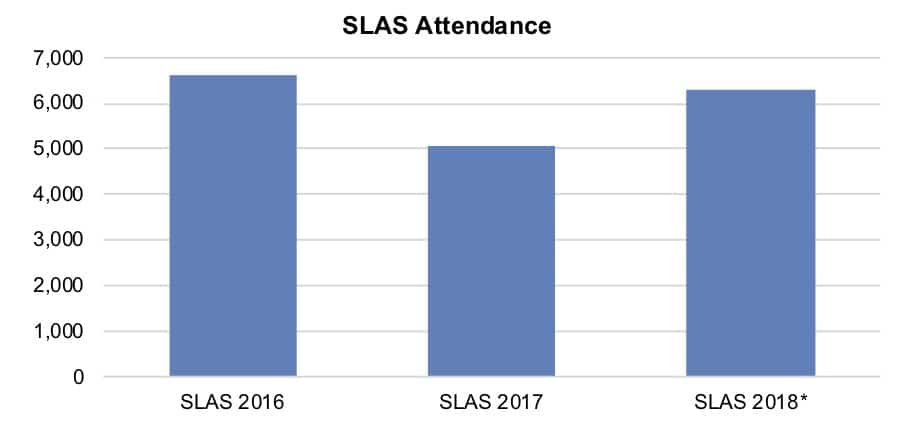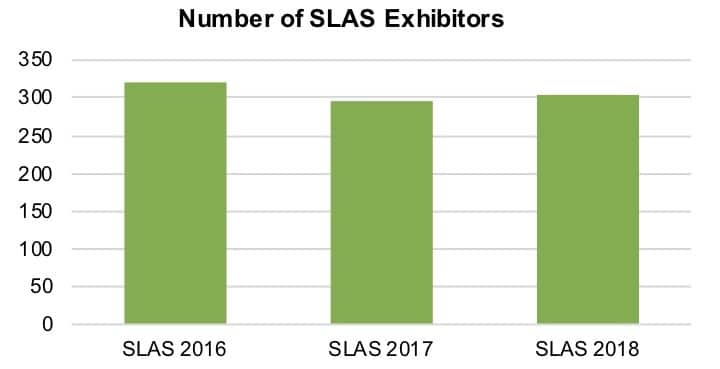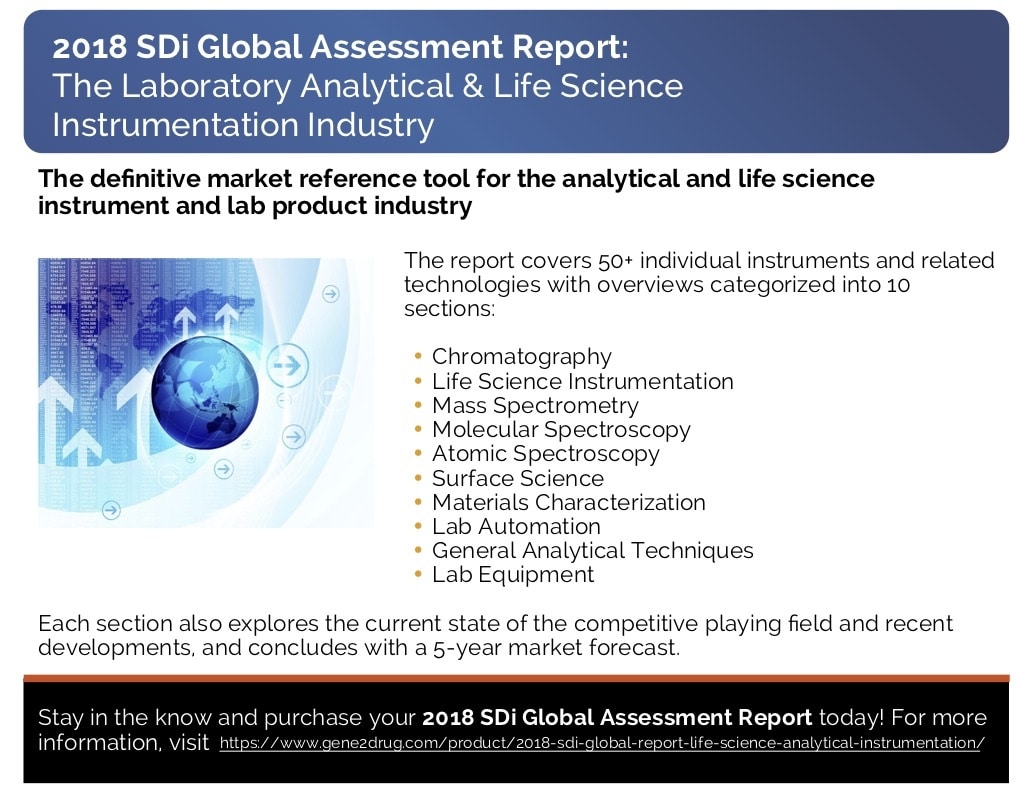SLAS 2018: Companies Unveil New Platforms
Held in San Diego, California, the seventh annual SLAS (Society for Laboratory Automation and Screening) conference took place from February 3 to February 7. Conference attendance rose 24.3% from last year (see IBO 2/15/17), when the conference took place in Washington, DC, to 6,628 participants, according to preliminary figures.
As usual, the conference and exhibition focused not only on laboratory automation, but also associated techniques addressing the challenge of making biological analyses more efficient, more informative and faster. As in years past, areas of particular emphasis not traditionally associated with lab automation included informatics, MS, cellular biology, microfluidics and NGS. The show is focused on pharmaceutical applications, stemming from a history rooted in HTS, and the continuing challenges in reducing the costs and improving the efficiency of drug discovery.
In June, SLAS will hold its first European conference in Brussels, Belgium, from June 27 to June 29. Next year’s US conference will take place in February 2–6 in Washington, DC. SLAS 2020 and SLAS 2021 will again return to San Diego, while SLAS 2022 will move to Boston, Massachusetts.
Presentations
The Data Analysis and Informatics track featured a presentation by Scott Harrison, PhD, Principal Scientist at Merck entitled, “Preparing Early Drug Discovery for the Machine Learning Revolution.” Dr. Harrison discussed his experience at Merck utilizing Quantitative Structure Activity Relationships (QSAR) methods. Defining QSAR, he called it, “a form of machine learning that attempts to predict an activity of a compound using features present within the chemical structure.” Applications include polypharmacology modeling and high-throughput screening prioritization.
He emphasized the importance to the success of QSAR of what he termed the “human side of predictive sciences.” Key steps in this direction included convincing scientists of the meaningfulness of the data, embedding the platform in a workflow that chemists were already using and adjusting scientists’ expectations that QSAR would eliminate typical experimental error. He also emphasized the value of so-called “bad models” that show what will not work.
As part of the “High Definition Technology Platforms for Single Cell Analysis” track, Caltech Research Professor Long Cai presented his lab’s work using a seqFISH (Sequential Fluorescence in situ Hybridization) for in situ 3D multiplexed imaging of hundreds of RNA molecules within a single cell for transcriptional profiling. As Dr. Cai noted, single molecule FISH is currently the “gold standard” for quantifying mRNA. His lab employs the multiplex capacity of seqFISH by using temporal barcodes, rather than spatial or spectral barcodes. One of the advantages of temporal barcoding is it can hybridize against the same RNA multiple times, with an exponential increase in multiplexing. He also noted that single cell RNAseq data can be mapped to seqFISH data.
New Automation Approaches
On display in the exhibition hall was the evolution of lab automation even for the most established of technologies. Two companies at the show challenging traditional lab automation design were HighRes Biosolutions and Formulatrix. Formulatrix previewed its ROVER Laboratory Automation Platform, which utilizes autonomous, compact moving or “roving” boxes to move microplates between stackers and dispensers using machine vision. This provides flexibility and scalability with up to five “rovers” that can be used simultaneously. Pipetting stations employ sensors to automatically adjust for liquid level, liquid class and labware geometry. The company told IBO that the system eliminates the need for a traditional automation engineer. The system is expected to launch next year.
HighRes Biosolutions’ Prime integrates liquid handling, labware transport and labware storage into a vertical, mobile platform. It reconfigures the traditional layout of workbench from a horizontal to a vertical orientation to address the problem of unused deck space and shrink the overall footprint. A dynamic tray system and under-deck plate storage enables continuous pipetting and reloading. Safety sensors eliminate the need for physical guarding and improves flexibility. The movable system with on-system gas, ethernet and electrical connections allows for easy docking to other modules for quick reconfiguration for other applications. Pricing starts in the low $300,000s. The company told IBO that it aims to broaden the range of what can be automated.
A partnership was also behind the introduction of the new Access Dual-Robot System. The high-throughput, modular platform, developed by LabCyte, Brooks Automation and Titian Software, creates an integrated automation system for use with LabCyte’s acoustic liquid handling technology. It features two robots for parallel processing, ability to add shelves and docks to expand, as well as redundant devices to ensure continuous operation, and an environmental distribution system. The Access incorporates sample handling, storage and management, as well as liquid dispensing and transfer. The system’s capabilities are made possible by LabCyte’s new Echo 655T Liquid Handler. The company’s first system to work with both plates and tubes, the system can dispense DMSO and aqueous fluids. Designed especially for the Echo 655T, Brooks Life Sciences’ new FluidX AcoustiX Sample Tubes, are designed for long-term storage and a barcode compatible with acoustic liquid handling. The three new products are expected to ship within the next couple of months.
Asked about the creation the sample management systems, Chris Grimley, vice president of Marketing for LabCyte, told IBO, “Developing a system with the level of sophistication and complexity of the new acoustic sample management solution would be extremely challenging for any single company. By choosing to collaborate with Labcyte, Brooks Life Sciences and Titian Software, AstraZeneca has ensured that they will receive a fully integrated and tested system that represents the state of the art in all the key technology areas related to sample management, namely liquid handling, automation, compound storage and software integration.”
Clinical
SLAS 2018 also marked the debut of Tecan’s Fluent Gx workstation, the latest model of the company’s Fluent workstation platform. The Fluent Gx is designed for clinical and regulated environments, including NGS sample preparation and nucleic acid purification. Based on the Fluent 2018 model, launched late last year, the Fluent Gx adds the Fluent Gx Assurance Software for ease of use and regulatory compliance. The Fluent Gx is expected to be registered with the US FDA as a Class I Medical Device in coming months. The platform is currently available in Europe. At a press conference announcing the introduction, Tecan CEO David Martyr highlighted the company’s presence in the clinical diagnostics market, noting that the market accounts for over 60% of revenues. Around one hundred employees work in quality and regulatory positions at Tecan.
Complete Solutions
PerkinElmer and Thermo Fisher Scientific are two companies that provide users with a package of lab automation products: instruments, kits, consumables and software. PerkinElmer exhibited a number of new products and assays at SLAS 2018. Speaking with IBO, Alan Fletcher, PhD, vice president and general manager of the Discovery Solutions business at PerkinElmer, discussed the interactions between the company’s Diagnostics division and its Discovery Solutions business, which also includes offerings for LDTs. Mark Dupal, Global Portfolio Director, Microfluidics and Automation, Applied Genomics, for PerkinElmer explained, “The JANUS system has two types: a Research Use Only (RUO) and an IVD version. We manufacture all the JANUS instruments under the same IVD process though.” Mr. Dupal also mentioned the company’s work to utilize its automation capabilities for its food testing business.
Dr. Fletcher also noted the company’s broad set of automation solutions, both instruments and kits. The extensive set of kits targets all biomarkers of choice: genes, proteins or cells. The company launches with 10–12 kits each month. Dr. Fletcher told IBO that “we have reinvigorated our entire portfolio of assays, but with a focus on cell-based assays.”
At the show, the company highlighted the high-throughput NEXTprep-Mag Automated cfDNA isolation kit for extraction of cell-free DNA (cfDNA) from plasma or serum, which was released this quarter. Applications include NIPT and oncology. Dr. Fletcher told IBO that the question currently being addressed around cfDNA is not if it is useful, but how useful it can be, for example, in applications such as monitoring tumors. The booth also featured an expanded line of LANCE Ultra TR-FRET assays.
Among the instruments on display in the booth was the compact VICTOR Nivo Multimode Plate Reader, released last fall, which replaces the VICTOR X platform. It measures 8 x 11 in (20 x 27 cm). For use with both biochemical and cell-based assays, the Reader is designed for academic labs and more routine applications such as assay development. Its compact size is made possible by a mechanical filter wheel for both excitation and emission.
Thermo Fisher Scientific announced three new products at the show. The Thermo Scientific inSPIRE is a vertical robotic platform designed for users looking for an automation system with capabilities between benchtop and industrial-scale systems. It enables integration of multiple instruments through shelving modules. Up to four shelves can be added with additional access via docking tables. Addressing user experience, the system is remarkably quiet with lighted handles to provide visual signal as to system operation. Shipments will begin in the third quarter with orders taken starting in the second quarter. The system incorporates the new Thermo Scientific Spinnaker XT robot with vision capability for self-correction.
The company also launched the Thermo Scientific Cytomat SkyLine microplate storage and delivery system, claiming the highest capacity at 728 microplates. The plate separation technology allows plates and plate lids to be handled separately.
Launching its first in a series of application-based turnkey workflow solutions, Thermo Fisher introduced a cfDNA extraction solution incorporating several of its tools, the MagMAX Cell-Free DNA Isolation kit, protocols, as well as Analytik Jena’s CyBio FeliX liquid handler. Other turnkey systems to be launched are those for ELISAs, NGS library preparation.
Cell Analysis
At SLAS 2018, Corning launched the $3,000 Corning Cell Counter, exclusively available from Corning through a collaboration with CytoSMART Technologies. The compact Counter, weighing only 2 lb (1 kg), enables cell counting uses standard reusable hemocytometers or disposable slides. As Keith R. Olson, PhD, director, CLS Business Operations for Corning, told IBO, the addition is part of Corning’s efforts to offer researchers a complete workflow for cell culture. Through acquisitions and product development, as well as long-established product lines and brands, the company has steadily expanded such offering to encompass media, sera, vessels, surface and liquid handling equipment.
Corning also highlighted at the conference a new product line, Corning Dissolvable Microcarriers. As Dr. Olson explained, although microcarriers are not a new technology for cell culturing in bioreactors, the dissolvable microarrays utilize a plant-based polymer and enzyme, which are more gentle to cells during separation from the carrier. Corning plans to introduce its 1,536 Spheroid microplates in June and spheroid technology for flasks as early as next year.
Miltenyi Biotec displayed its MACSQuant X flow cytometer. Released in late 2017, the system is configured for high-throughput cell analysis and volumetric counting at high speed, with 3D plate compatibility. The model does not feature cell separation capabilities. The fully automated system tracks reagents via barcode, and is priced at about $200,000.
Miltenyi Biotec also displayed the multiMACS X automated cell separator, which has been on the market for about six months. The system adds automation (via a partnership with Tecan) to automate cell separation with Miltenyi Biotec’s magnetic bead technology and products, thus enabling high-throughput processing with true walk-away capabilities. The system can be configured to provide both positive and negative selection, and is priced starting at about $160,000.
Molecular Devices introduced a new model in its ImageXpress line of high-content imaging systems, the ImageXpress Pico. While some of the products of the line use confocal imaging systems, the Pico uses a widefield CCD detector to produce automated cellular images. While this choice limits performance–particularly the absence of 3D imaging that confocal optics can provide–the company is confident that the instrument will appeal to researchers as a “personal” imager, with its small footprint and modest pricing. The new model is expected to begin shipping in a few months at a price in the $50,000s.
Sphere Fluidics premiered its Cyto-Mine Single Cell Analysis System. The system is capable of high-throughput analysis, sorting, imaging and dispensing of single cells. Using picodroplet technology, cells are encapsulated in growth media, while multiple imaging sensors select for picodroplets containing only single cells. Sorting via fluorescent-tagged antibodies allows screening for rare cells. The cartridge-based platform will facilitate expanded functionality in the future, as cartridges for label-free and gene editing selection are under development. The cost of the system is about $500,000.
StemoniX introduced its Assay Ready line of pre-plated cells. Available in 96- or 384-well formats, the plates are ready to use for high-throughput screening and drug discovery. Cell types currently available are iPSC-derived human cortical spheroids, cortical neurons and astrocytes, multipotent neuroprogenitor cells and cardiomyocytes. Cells are plated at high density with one spheroid per well. StemoniX has also formed agreements with leading research institutes to release pre-plated specialty cell lines in the near future.
Protein Based
Part and parcel of the lab automation market are partnerships, particularly as companies seek to compete with one-stop shops by providing integrated solutions. Abcam and Molecular Devices announced a collaboration at the show. Abcam will provide its CatchPoint SimpleStep ELISA kits optimized for use with Molecular Devices’ multimode plate readers. This is one in a series of kits the companies plan to launch and expands Abcam’s ELISA kits from colorimetric to fluorescent detection. The kits are currently available through Abcam.
Matthew Grow, PhD, senior director, Kits and Assays, at Abcam told IBO, “This is the first product of our strategic collaboration with Molecular Devices. Although CatchPoint SimpleStep ELISAs have been optimized with Molecular Devices’ plate readers, they also can work with a number of other standard fluorescence plate-readers that cover the required fluorescence excitation and detection ranges. No other systems have been tested, and so with any untested system, assay optimization prior to using the assays to collect data is essential.”
Abcam also showcased the FirePlex-HT multilplex immunoassay for high-content imaging. The 384-well assay measures up to 10 parameters with a two-step workflow and no-wash assay. The assay has been validated for use with the following instruments: Molecular Devices’ ImageXpress Micro, TTP Labtech’s Mirrorball, PerkinElmer’s Opera Phenix and Yokogawa’s Cell Voyager 7000. Also available is a High-Content Imager Setup Kit to help researchers set up their laboratory for successful assay readout. Dr. Grow told IBO, “We are actively working with researchers to validate other imaging systems using this kit.”
German firm NanoTemper Technologies displayed its recently introduced Tycho NT.6 system for checking protein quality. Applications include assay development and protein characterization. Tycho runs up to six samples at a time and utilizes a capillary format to conduct protein measurements in solution. Experimental run time is three minutes using only 10 µL of sample.
As Peter Fung, PhD, senior manager, Product Marketing, at NanoTemper told IBO, “Tycho can be used for both upstream and downstream processing to quickly monitor protein quality. It helps determine which samples to move forward with before committing to other experiments or more detailed characterizations.” He added, “Tycho measures the changes in the intrinsic fluorescence of a protein as a thermal ramp is applied. These changes indicate transitions in the protein’s folded state. This provides information on the integrity and functionality of a sample. Researchers use Tycho to examine the effects of various buffers, different pHs and storage conditions on the quality of their protein samples.
The new NT.Robotic Autosampler is used with the company’s Prometheus NT.Plex to fully automate and screen samples by measuring protein stability.
Expanded Product Lines
Among the software companies exhibiting at SLAS 2018 was Dotmatics. An ELN and lab management software firm, Dotmatics has expanded from chemistry into biological solutions, which includes the Bioregister registration system for sequence-based, chemically modified and structure-less biological entities. Discussing the adoption of cloud-based computing, the company told IBO that many of its customers use both private and public clouds, and many have transitioned to the cloud following on premise installations. The company’s biologics offerings also include the Vortex visualization solution for the analysis and presentation of data for collaborative research.
Hudson Robotics introduced an updated version of its Rapid-pH system for measuring pH in 96 well-plates. The new system includes an improved electrochemical head from Mettler-Toledo. In the future, potential new probes could be used to provide conductivity or other measurements. The benchtop system is small enough that it can fit inside a fume hood. The system is now available at a price of about $35,000.
Lab automation product provider and integrator Peak Analysis & Automation (PAA) announced the US launch of its low-cost compact S Lab automated plate handler with a capacity of up to 100 microplates. The system works with both unlidded and lidded plates. It features a fixed radius. The company also displayed the GX benchtop robot which features a 360° rotation on all axes as well as the ability to handle microplates in vertical or portrait orientation.




